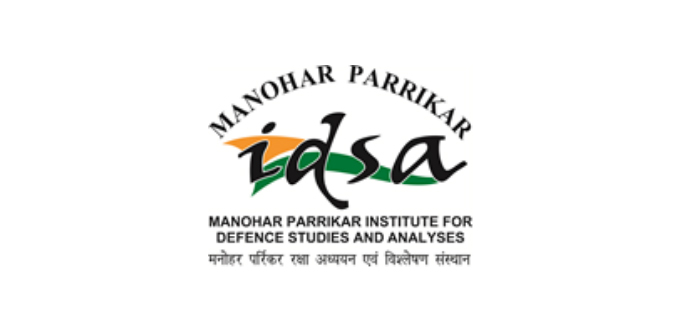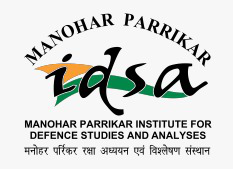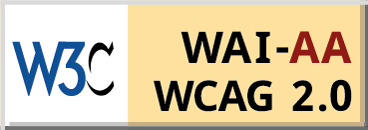
- This event has passed.
MP-IDSA Fellows Seminar: ‘Maritime Capacity Building in the Western Indian Ocean: Analysing the Role of International Maritime Organisation, The United Nations Office on Drugs and Crime and the European Union’

The MP-IDSA Fellows Seminar by Dr. Abhishek Mishra Associate Fellow, on ‘Maritime Capacity Building in the Western Indian Ocean: Analysing the Role of International Maritime Organisation, The United Nations Office on Drugs and Crime and the European Union’ was held on 25 July 2025. It was chaired by Vice Admiral Shekhar Sinha, PVSM, AVSM, NM & Bar (Retd.), Chairman, Board of Trustees, India Foundation, New Delhi. The External Discussant was Rear Adm. Monty Khanna, AVSM, NM (Retd.), Member, National Security Advisory Board (Online from Goa) and the Internal Discussants were Cmde. Abhay K. Singh (Retd.), Research Fellow, Southeast Asia and Oceania Centre, MP-IDSA; Dr. R. Vignesh, Associate Fellow, Military Affairs Centre, MP-IDSA
Executive Summary
The presentation examined the Western Indian Ocean (WIO) as a vital maritime region where international organisations and external actors have tested varied models of capacity building over the last two decades. Initially driven by counter-piracy imperatives, efforts have since broadened to encompass maritime security and blue economy priorities. Case studies of the International Maritime Organisation (IMO), the United Nations Office on Drugs and Crime (UNODC), and the European Union (EU) illustrate distinct approaches: institutional capacity development (Djibouti Code of Conduct), criminal justice reform (Maritime Crime Programme), and integrated security–development frameworks (Operation Atalanta and CRIMARIO).
Detailed Report
Presentation by Dr. Abhisek Mishra
Dr. Mishra began by outlining the rationale of his study, observing that the Western Indian Ocean (WIO) is a coherent geographic region stretching from Somalia to South Africa and including island nations such as Seychelles, Mauritius, Madagascar, and Comoros. With a coastline of nearly 15,000 kilometres, a continental shelf of 450,000 square kilometres, and natural assets worth an estimated USD 333.8 billion, the WIO is a region of immense strategic and economic significance. Historically, it served as a vital trade corridor between the Persian Gulf, the Indian subcontinent, and beyond. Yet, after the wave of decolonisation, the region fell into relative neglect, as global attention shifted to other theatres.
The early 2000s, however, marked a turning point. Rising incidents of piracy off Somalia, the 2000 attack on USS Cole, and the 2002 Limburg bombing in Yemen underscored the vulnerability of maritime traffic and catapulted the WIO into the international security agenda. Dr. Mishra emphasised that piracy was not just a law enforcement problem but a systemic threat to global commerce. By 2008, the situation had escalated to such an extent that the international community began to mobilise a broad array of responses, turning the WIO into a testing ground for capacity-building initiatives designed to address maritime insecurity.
From a conceptual standpoint, Dr. Mishra explained that capacity building has its roots in post-World War II development assistance, which initially involved technical training, financial aid, and institution-building in newly independent states. By the 1990s, with the rise of discourse on “failed states” and security sector reform, capacity building assumed a prominent place in international security practice. In the maritime domain, this took the form of both capacity building assistance—providing hardware such as vessels, radars, or coastal surveillance systems—and capability enhancement through training, legal reform, and skill development. The WIO, he argued, became an “international laboratory” for experimenting with such capacity building approaches.
In this context, the International Maritime Organisation (IMO) played a central role through the 2009 Djibouti Code of Conduct (DCoC), signed by 21 countries. Loosely modelled on the earlier ReCAAP agreement in Asia, the DCoC sought to build regional capacity against piracy by establishing information-sharing centres in Mombasa, Dar es Salaam, and Sanaa, although the latter has been defunct since 2019 due to conflict. It also created training facilities such as the Djibouti Regional Training Centre, supported by Japan and European donors. Over time, amendments broadened its scope to include wider maritime crime and even blue economy issues. Nevertheless, Dr. Mishra noted that these initiatives faced limitations: they focused too narrowly on piracy without integrating multi-agency approaches, while littoral states such as Seychelles and Kenya often prioritised tangible assets like patrol vessels over workshops and training measures. Moreover, coordination problems and lack of sustainable funding hampered the effectiveness of such training programs, thereby underscoring that no single agency could monopolise the maritime domain and that inter-agency cooperation and local ownership were indispensable.
A complementary but distinct effort was made by the United Nations Office on Drugs and Crime (UNODC) through its Maritime Crime Programme (MCP), launched in 2009 to address the absence of robust criminal justice mechanisms to prosecute pirates. The programme facilitated prisoner transfer agreements, developed prosecution models, and strengthened judicial capacity in countries like Seychelles and Kenya. By reforming criminal justice frameworks and mentoring police and coastguard agencies, the UNODC sought to move beyond narrow counter-piracy responses toward more holistic maritime security governance. Combined with bureaucratic inefficiencies and under-resourcing, this meant that the MCP achieved only partial success. Nonetheless, its emphasis on legal and judicial capacity represented a valuable innovation in the WIO region’s maritime governance landscape.
Parallel to these developments, the European Union emerged as a particularly active actor through its Common Security and Defence Policy. Operation Atalanta, launched in 2008, deployed naval forces to protect World Food Programme vessels and deter piracy. This military mission was complemented by civilian-led initiatives such as the MASE program and CRIMARIO, which emphasised information sharing and maritime domain awareness. The EU even expanded its focus geographically, extending CRIMARIO’s scope from the WIO to the broader Indo-Pacific. Despite these ambitious efforts, EU programmes often suffered from excessive bureaucracy, overlapping mandates, and donor-driven priorities. African stakeholders frequently complained that these initiatives were designed with little consultation, privileging European energy routes over African community concerns such as illegal, unreported, and unregulated fishing. While the EU succeeded in building some regional information networks, its fragmented approach raised questions about sustainability and local ownership.
Bringing these threads together, Dr. Mishra argued that India must draw lessons from these experiences as it recalibrates its maritime strategy. Under SAGAR— “Security and Growth for All in the Region”—India positioned itself as a net security provider in the Indian Ocean. With the recent articulation of India’s MAHASAGAR framework, this vision has expanded to include East African littorals and the wider Indo-Pacific. India must back its declaratory visions with delivery, consistency, and trust-building. This requires balancing naval deployments with capacity building, integrating African priorities such as combating IUU fishing, and ensuring sustained cooperation in maritime domain awareness. Only by doing so can India consolidate its credibility and strengthen its role as a responsible stakeholder in the evolving maritime order of the Western Indian Ocean.
Discussants’ Comments
Rear Adm. Monty Khanna (External Discussant)
Rear Adm. Khanna commended the paper’s comprehensive scope and its timely focus on the WIO, a region of increasing importance for India. He nevertheless pointed to critical gaps. First, he noted the absence of a clear India angle in the written paper, even though the presentation included some references. He urged Dr. Mishra to integrate India’s interests and contributions more explicitly. Second, he suggested including China as a major external actor, given its expanding naval and economic presence in the region.
On the case studies, Rear Adm. Khanna highlighted that the IMO’s DCoC had achieved significant progress in training and information sharing, but fell short in translating skills into assets and surveillance systems. He criticised the UN for allowing fragmented coalitions to dominate counter-piracy operations rather than establishing a centralised UN maritime framework. The EU, he argued, was hampered by excessive acronyms, institutions, and bureaucratic overlap. Khanna also stressed that India’s MAHASAGAR initiative must not remain a slogan like SAGAR. It needs policy depth, institutional mechanisms, and branding, similar to China’s Belt and Road Initiative. He proposed a “comparative analysis” in the paper to identify which of the three models was most successful and why, as this would make the research more policy-relevant.
Cmde. Abhay K. Singh (Internal Discussant)
Cmde. Singh focused on the theoretical underpinnings of capacity building. He drew a distinction between capacity building assistance (providing physical assets such as radars, vessels, or platforms) and capability enhancement (skills, training, and knowledge). Using this prism, he argued, one can better evaluate whether initiatives truly addressed African needs. For example, the UNODC focused primarily on capability enhancement through legal reforms, while the IMO attempted a mix of both hardware and training. He cautioned that much of the international approach has been elitist, prioritising piracy which threatened global shipping over issues like IUU fishing that affect African communities more directly. He cited critiques that EU programs were overly military-centric, donor-driven, and insufficiently consultative. For India, Cmde. Abhay K. Singh argued, the lesson is to avoid top-down approaches and instead build cooperative frameworks that resonate with African priorities.
Dr. R. Vignesh (Internal Discussant)
Dr. Vignesh praised the paper’s information-rich narrative but suggested strengthening its analytical depth. He recommended including a dedicated comparative case study section that identified common successes and limitations of the three initiatives. Such a section, he argued, would provide a useful template for future multi-actor capacity building projects. He also urged incorporating African perspectives, particularly criticisms that donor-driven programs often undermined African autonomy. Dr. Vignesh highlighted the importance of law enforcement challenges: for example, during the height of piracy, captured suspects were often released because of jurisdictional gaps. The UNODC’s prisoner transfer program partially addressed this, but similar models could be extended to other maritime crimes such as IUU fishing. Finally, he recommended elaborating on the role of external powers. While the paper mentioned militarisation and competition, it could examine more closely how actors like China, France, and the US shape maritime security dynamics in the WIO.
Chair’s Comments: Vice Admiral Shekhar Sinha
Vice Admiral Sinha congratulated Dr. Mishra for producing a timely and well-researched paper. He echoed the discussants’ view that India’s role must be central to the analysis. Specifically, he pointed out that the paper overlooked the role of the Combined Maritime Forces (CMF) and India’s recent membership in Combined Task Forces (CTFs), which are crucial to maritime security in the Arabian Sea and Gulf of Oman. On MAHASAGAR, Sinha cautioned against confining its scope to the Indo-Pacific. Since it is increasingly linked to the Global South, its definition should remain flexible enough to encompass Africa, Latin America, and beyond. Drawing a parallel with China’s BRI, he emphasised the need for institutionalisation. Slogans and vision statements must be backed by policies, resources, implementation, and monitoring mechanisms. Without this, India risks repeating the limitations of SAGAR.
He further highlighted Maritime Domain Awareness (MDA) as India’s most impactful contribution. By integrating African states into India’s Information Fusion Centre for the Indian Ocean Region (IFC-IOR) and regional MDA networks, India can provide tangible value. He cited the importance of combating IUU fishing, which affects African livelihoods but often receives less attention than piracy. For India, MDA offers a credible entry point to align with African priorities while reinforcing its security provider image.
Director General’s Comments: Amb. Sujan R. Chinoy
Ambassador Chinoy offered strategic perspectives. He suggested that the paper should incorporate Indo-US cooperation on critical and emerging technologies. India’s designation as a “Major Defence Partner” (2016) and STA-1 status (2018) has opened avenues for technology transfers such as the GE-414 jet engine deal. These developments have implications not only for India’s defence industrial base but also for its maritime exports and capacity building.
Ambassador Chinoy underscored that MAHASAGAR must not be confined to the Indo-Pacific alone. Rather, it should be conceptualised as a flexible and inclusive framework that positions India as a maritime partner for the entire Global South. He argued that India’s engagement with Africa, Latin America, and other regions should fall under its ambit, ensuring that Mahasagar becomes a global rather than a regional initiative. Drawing parallels with China’s Belt and Road Initiative, he stressed that Mahasagar must evolve beyond a declaratory slogan into a robust framework supported by branding, secretarial support, institutional backing, and monitoring mechanisms. Only through such institutionalisation, he noted, could India’s maritime vision achieve sustained visibility and strategic impact.
Question & Answer
The Q&A session touched on several practical issues. Participants asked about the difference between capacity building and capability enhancement, to which Rear Adm. Khanna clarified: capacity building involves hardware (radars, coastal stations, platforms), while capability enhancement is software (training, legal frameworks, skill sets). Both are essential, but without training, hardware investments yield little value.
Another question addressed India’s coordination with EU and US programs. Dr. Mishra explained that India cooperates mainly through information sharing under the Djibouti Code of Conduct and regional centres, though structured joint programs are still limited. Recent green shoots of India-EU naval cooperation in the Gulf of Guinea were noted as promising. Other interventions raised the issue of African ownership.
Participants also highlighted law enforcement challenges. During peak piracy years, navies often had to release captured suspects due to lack of jurisdiction. The UNODC’s prosecution models helped, but further reforms are needed. Questions were also raised about regional organisations such as ECOWAS and the Indian Ocean Commission, which could play stronger roles in setting African priorities. Finally, participants urged India to strengthen its presence in Maritime Domain Awareness initiatives and integrate African states more fully into platforms such as the IFC-IOR and the Colombo Security Conclave.
Dr. Abhishek Mishra thanked all discussants and participants for their constructive feedback. He acknowledged that this was a working paper and committed to incorporating suggestions on India’s role, comparative analysis, and African perspectives in the final version. The Seminar underscored the strategic importance of the Western Indian Ocean and the need for sustainable maritime capacity building. International initiatives led by the IMO, UNODC, and EU have made valuable contributions but also revealed structural weaknesses, ranging from donor-driven priorities to limited African ownership. For India, the key lesson is to design cooperative frameworks that balance hard capacity building with skill enhancement, align with African priorities such as IUU fishing and MDA, and back declaratory visions like Mahasagar with institutional depth. Only then can India consolidate its role as a credible maritime partner for Africa and the wider Global South.
The report has been prepared by Mr. Mohanasakthivel J., Research Analyst, Africa, Latin America, Caribbean and UN (ALACUN) Centre, MP-IDSA.




